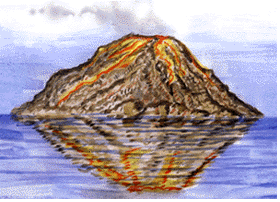...Best of Sicily presents... Best of Sicily Magazine. ... Dedicated to Sicilian art, culture, history, people, places and all things Sicilian. |
by Ignazio Lo Verde | ||
Magazine Index Best of Sicily Arts & Culture Fashion Food & Wine History & Society About Us Travel Faqs Contact Map of Sicily |
Then, on the morning of 10 July, a singular event took place. A volcanic island started to emerge in the sea about forty kilometres south of the coastal city of Sciacca. It began as a column of water spouting from below the surface. By the 18th, the islet was visible from the Sicilian coast. A crater was soon evident, spewing forth lava and ash. The Sicilians immediately christened the island Ferdinandea, in honour of their king. The Two Sicilies was not, however, the only sovereign power to claim the island. A British ship's crew observed the phenomenon and sent out a craft with sailors who planted the Union Jack, declaring the Graham Island British territory. A Sicilian naval crew was sent with orders to plant the Neapolitan flag. The conditions were ripe for an international dispute, but on 3 August the island submerged. It only emerged once more, and very briefly, in 1868. In 1848, American author James Fenimore Cooper took the event as inspiration for "The Crater," a story set in the Pacific. The area of Ferdinandea was identified on English maps as "Graham's Shoal," and as it lies only about three metres below the surface it is avoided by ships. About the Author: Professor Ignazio Lo Verde lectures on classics and architecture. | |
Top of Page |
 In July 1831, King Ferdinando II of the Two Sicilies (Naples and Sicily), who had only recently succeeded his father, Francesco I, was visiting Sicily in an effort to ascertain the island's needs for infrastructure development, particularly things like roads in areas around Agrigento and Caltanissetta. Though the monarch spent most of his time at Naples, Sicily remained an important element in his realm. Despite the nobility's longstanding reservations about rule from Naples, the King was warmly welcomed everywhere he went. The Sea, however, was calm.
In July 1831, King Ferdinando II of the Two Sicilies (Naples and Sicily), who had only recently succeeded his father, Francesco I, was visiting Sicily in an effort to ascertain the island's needs for infrastructure development, particularly things like roads in areas around Agrigento and Caltanissetta. Though the monarch spent most of his time at Naples, Sicily remained an important element in his realm. Despite the nobility's longstanding reservations about rule from Naples, the King was warmly welcomed everywhere he went. The Sea, however, was calm.